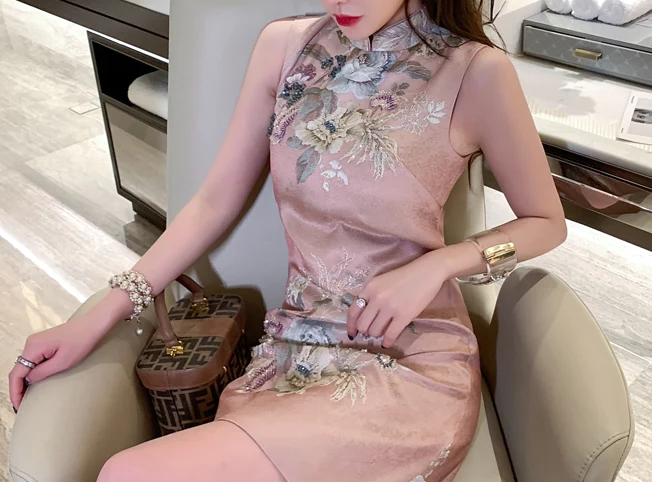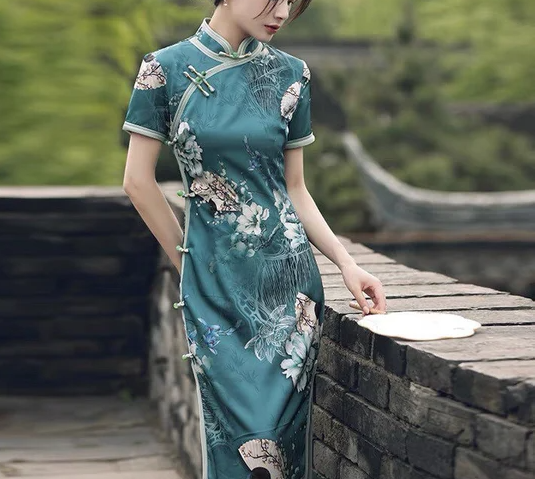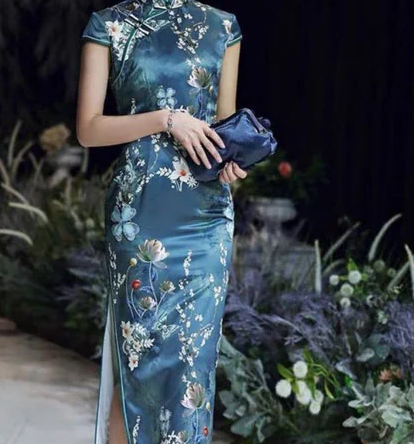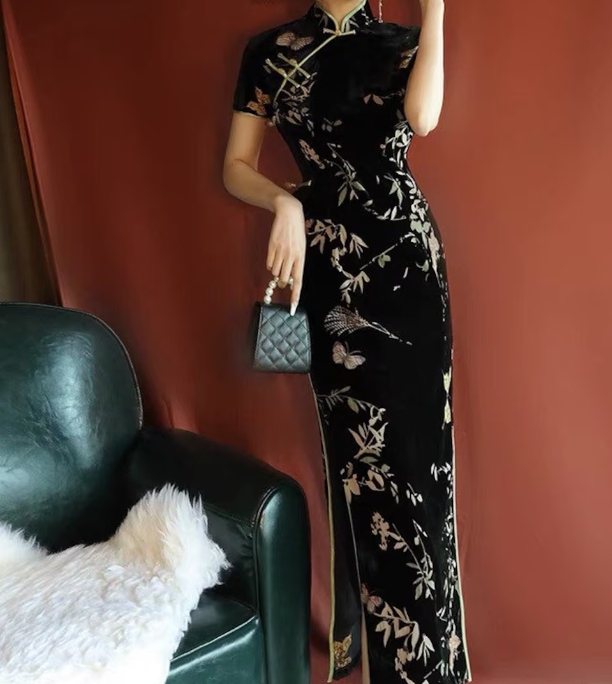The best Qipao color depends on personal preferences, cultural significance, and the occasion.
Introduction
The Qipao, also known as Cheongsam, is not just a dress; it’s a tale of Chinese history, evolution, and fashion blended into a single garment. Its journey from the Manchu-ruled Qing Dynasty to the bustling streets of Shanghai and then to the global stage is nothing short of captivating.

Brief History of the Qipao
Originating from the Manchu people during the Qing Dynasty, the Qipao was initially a loose-fitting dress that covered most of the wearer’s body. With the turn of the 20th century and the influence of Western culture, this traditional dress began evolving. By the 1920s and 1930s, in the vibrant city of Shanghai, the Qipao had transformed into a more form-fitting silhouette, emphasizing femininity and elegance.
Fashion trends shift with the sands of time, and by the mid-20th century, the Qipao experienced a decline in mainland China due to political changes and the introduction of more Western-style clothing. However, it made a revival in the late 20th century, becoming not just a symbol of tradition but also of modernity and sophistication.
Significance of Color in Chinese Culture
Colors in Chinese culture are not mere visual delights; they carry deep symbolic meanings, often rooted in history and folklore. The color red, for instance, is not just a vibrant shade; it symbolizes luck and prosperity. Gold, on the other hand, is associated with wealth and high status. Blue, inspired by nature, represents tranquility and peace. Such associations have been weaved into the cultural fabric over centuries, making colors an integral part of important life events, rituals, and even everyday life.
Choosing a color for a Qipao isn’t merely about aesthetic appeal; it’s a decision influenced by personal beliefs, the occasion, and the message one wants to convey. For instance, during a wedding, brides often opt for red Qipaos, emphasizing the wish for a happy and prosperous marital life.
The Symbolism of Different Colors
Color is a potent element in any culture, and in Chinese traditions, it’s particularly profound. Different shades have been embedded with meanings over millennia, guiding choices in art, fashion, and even daily life.
Red: Prosperity and Happiness
No color is as celebrated in Chinese culture as red. Representing vitality and the sun, red is seen as the harbinger of happiness and prosperity. It’s no wonder that many events, especially festivals like Chinese New Year, feature red prominently. Red envelopes, or “hongbao”, are given as gifts, filled with money to bestow blessings. In terms of materials, rich silk Qipaos with golden embroidery often showcase this vibrant hue.
Blue: Tranquility and Elegance
Blue, often seen reflecting in China’s vast lakes and rivers, stands for tranquility and elegance. In ancient Chinese paintings, blue often paints the skies and waters, representing vastness and depth. A blue Qipao may not be as commonly worn as its red counterpart, but it’s chosen by those seeking a calm and composed aura.
Yellow: Imperial and Auspicious
The color of gold and sunflowers, yellow, was once reserved for the emperor in ancient China. Reminiscent of the Forbidden City in Beijing, where yellow tiles represent the emperor’s exclusive dominion, this color speaks of authority and auspiciousness. When a Qipao is adorned in yellow, it often has intricate patterns that amplify its regality.
Green: Growth and Harmony
Green, the color of bamboo and jade, symbolizes growth, health, and harmony. It brings to mind spring, where new life emerges, and nature flourishes. A green Qipao could be made of fine materials like jadeite or be embroidered with nature-inspired motifs.
Black: Mystery and Sophistication
Black, a hue that holds the night’s essence, represents mystery, sophistication, and sometimes, even protection. It’s a color that’s both grounding and enigmatic. A black Qipao can often be seen at formal events, representing the epitome of elegance and grace.
White: Purity and Simplicity
In many cultures, white is a symbol of purity, and in Chinese culture, it’s no different. Often associated with jade, a gemstone revered in China, white also denotes simplicity and perfection. However, it’s also associated with mourning, so its use in festive occasions is limited.
Pink: Romance and Tenderness
Pink, a softer hue of red, encapsulates romance, tenderness, and youthful exuberance. Perfect for events like spring gatherings, a pink Qipao often feels fresh and optimistic.

Choosing a Qipao Based on Occasion
Selecting the right Qipao isn’t solely about personal preference. The occasion, too, plays a pivotal role. Each event carries its ethos and requires a specific aura, which can be amplified or diminished by the choice of Qipao color and design. Let’s delve into the considerations for various occasions:
Wedding Ceremonies: Auspicious Colors
For weddings, the stakes are high, and every detail counts. The bride’s Qipao often leans towards red, symbolizing happiness, prosperity, and a blissful future. Gold embroidery, representing wealth and nobility, is a frequent addition. The richness of the fabric, often premium silk, elevates the dress’s grandeur. Price-wise, such Qipaos can range from $200 to well above $2,000, depending on the intricacy of designs and quality of materials.
Business Events: Professional and Subdued Tones
At business events, where formality and professionalism are paramount, the choice of Qipao leans towards muted colors. Navy blue, deep green, and charcoal are often preferred. These colors exude confidence, stability, and respect. The material, often a blend of silk and polyester, offers a balance between elegance and durability. Such Qipaos typically fall in the range of $100 to $500, depending on the quality and brand.
Casual Gatherings: Bright and Cheerful Shades
For casual gatherings with friends and family, one might opt for Qipaos in brighter, more cheerful shades. Turquoise, peach, or light yellow are popular choices. These colors exude warmth, friendliness, and approachability. The materials can vary, but comfort is key, with cotton and linen blends often being the go-to. These Qipaos are usually more budget-friendly, priced between $50 to $200.
Traditional Festivals: Colors with Cultural Significance
During traditional festivals like the Mid-Autumn Festival or Dragon Boat Festival, Qipao colors with deep cultural resonance are preferred. Red, for fortune during the New Year, or green, representing growth during spring festivals, are common. These Qipaos often feature intricate embroidery showcasing dragons, phoenixes, or other culturally significant symbols. The price can vary significantly based on the workmanship and material, typically ranging from $100 to $1,000.

Personal Color Analysis: Finding Your Best Shade
Selecting the right Qipao color is not just about adhering to traditions or matching the occasion. It’s also about understanding one’s personal colors and choosing shades that flatter and enhance individual beauty. Personal color analysis helps in deciphering the hues that make one shine. Here’s how:
Understanding Skin Undertones
Everyone’s skin has undertones that influence which colors look best on them. There are generally three categories:
- Cool Undertones: Characterized by blue, pink, or purple hints. Silver jewelry typically complements this skin tone best.
- Warm Undertones: Dominated by peach, yellow, or golden tints. Gold jewelry often looks the most flattering.
- Neutral Undertones: A mix of both warm and cool hints, allowing a broader range of colors to be suitable.
To determine your undertone, a quick test involves observing the veins on the underside of the wrist. If they appear blue or purple, one likely has cool undertones. If green, the undertones are warm. A combination indicates neutral undertones.
Seasonal Color Analysis for Qipaos
Seasonal color analysis is an advanced method, breaking down personal colors into four seasons:
- Spring: Individuals falling under this category often have warm and clear undertones. Bright and clear colors like peach, coral, and golden yellow complement them best.
- Summer: With cool and muted undertones, soft neutrals like powder blue, lavender, and soft rose work wonders.
- Autumn: Representing warm and muted undertones, colors like olive, brick red, and mustard are ideal.
- Winter: Exuding cool and clear undertones, striking colors like navy blue, white, and crimson are top picks.
Choosing a Qipao based on one’s seasonal palette ensures the wearer shines in harmony with the dress.
Complementing Hair and Eye Color
Beyond skin undertones, hair and eye colors play pivotal roles in color choices:
- Blonde Hair: Pastel shades, particularly pinks and blues, elevate the radiance of blonde hair. Avoid overly dark colors as they can overshadow the hair’s natural glow.
- Brunette Hair: Deep and rich colors, from royal blue to emerald green, complement dark hair. Avoid overly pale shades that may wash out the overall look.
- Red Hair: Earthy tones like rust, terracotta, and forest green harmonize beautifully. Avoid bright reds and pinks which can clash.
- Black Hair: Almost every hue complements black hair, but jewel tones like ruby red, sapphire blue, and amethyst purple particularly stand out.
- Eye Color: Matching a Qipao color to one’s eye color, be it green, blue, brown, or hazel, can create a captivating effect. For example, a blue Qipao to complement blue eyes or a green one for green eyes can make the eyes pop.
Factors Influencing Color Choices
The art of selecting colors, especially in clothing, isn’t just about aesthetics or personal preferences. There’s a myriad of factors at play, shaping our choices, often subconsciously. From regional traditions to the latest runway showcases, let’s explore the driving forces behind our color decisions:

Regional Variations and Preferences
Different parts of the world, owing to their history, climate, and culture, have distinct color preferences:
- East Asia: In countries like China and South Korea, red is revered for its association with luck and prosperity. Especially in Qipaos, red is a popular choice for its auspicious symbolism.
- Western Europe: Navy blue and charcoal, representing elegance and sophistication, are preferred for formal wear.
- South America: Countries like Brazil and Argentina, known for their vibrant festivals, show a penchant for bright, lively colors like turquoise, fuchsia, and emerald green.
These regional inclinations can heavily influence an individual’s wardrobe, especially if they deeply identify with their roots.
Current Fashion Trends
Fashion is ever-evolving. What’s in vogue today might be passé tomorrow. Keeping up with fashion trends, however, plays a significant role in color choices:
- Fashion Weeks: Major cities like Paris, Milan, and New York host annual fashion weeks where top designers showcase their collections. If, for instance, lavender becomes the “it” color of the year, it’s likely to be seen everywhere, from dresses to accessories.
- Celebrity Influence: When A-list celebrities sport a particular color, it often trickles down to the masses. A classic example is the “Marilyn Monroe White”, inspired by her iconic white dress.
- Social Media: Platforms like Instagram and Pinterest, teeming with influencers and fashion bloggers, play a pivotal role in setting trends. A color that gains traction here can become an instant hit.
Personal Beliefs and Family Traditions
Often, our choices stem from deeply ingrained personal beliefs or family traditions:
- Symbolism: For some, colors carry specific meanings. Green might symbolize growth, while blue might represent tranquility. Such personal associations can heavily influence wardrobe choices.
- Family Traditions: In some families, certain colors might be considered lucky or favorable. For instance, a family might believe in wearing yellow during new beginnings, attributing it to good luck.
- Religious or Spiritual Beliefs: In many cultures, colors have religious significance. Saffron is revered in Hinduism, while green holds importance in Islam.